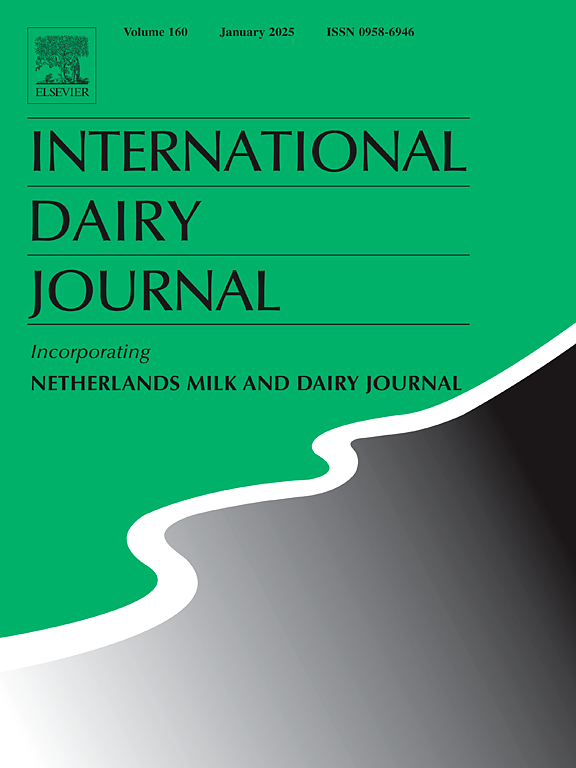Similar size distributions of casein micelles determined by cryo-electron microscopy and nanoparticle tracking analysis
IF 3.4
3区 农林科学
Q2 FOOD SCIENCE & TECHNOLOGY
引用次数: 0
Abstract
Nanoparticle tracking analysis (NTA) and cryo-transmission electron microscopy (cryo-TEM) were used to determine histograms of the number and volume fractions of different sizes of casein micelles in unprocessed cow milk samples. Using a composite of measurements on five individual raw milk samples, cryo-TEM data gave a unimodal histogram of volume fractions with a modal radius at 85 nm and full width at half height of 50 nm. With a sample of unpasteurized bulk milk, the corresponding figures from the NTA were a modal radius of 85 nm and full width at half height of 40 nm. Both histograms were skewed to larger sizes by a tail extending to a radius of 250–300 nm. Histograms of number fractions showed fewer smaller micelles by NTA than cryo-TEM. Even though different unprocessed milk samples were used, the results demonstrated that the rapid NTA method could give a very similar histogram of volume fractions to cryo-TEM. Histograms of the unprocessed milks could be fitted approximately by either the log-normal density distribution function or a discrete distribution of sizes derived from the multivalent-binding model of the casein micelle. The potential applications of the NTA method in dairy science and technology were demonstrated by the facile and rapid measurement of size histograms of commercial pasteurized or sterilized milk samples, which were distinctly different in shape from the unimodal histograms of unprocessed milk.
用低温电子显微镜和纳米颗粒跟踪分析确定了相似大小的酪蛋白胶束分布
采用纳米粒子跟踪分析(NTA)和低温透射电镜(cro - tem)测定了未加工牛奶样品中不同大小酪蛋白胶束的数量和体积分数的直方图。通过对5个原料奶样品的综合测量,低温透射电镜数据给出了体积分数的单峰直方图,其模态半径为85 nm,半高为50 nm的全宽。对于未经巴氏消毒的散装牛奶样品,NTA的相应数据为模态半径为85 nm,半高处的全宽为40 nm。两个直方图都被延伸到250-300纳米半径的尾巴扭曲成更大的尺寸。数字分数直方图显示,NTA比低温透射电镜显示更少的小胶束。尽管使用了不同的未加工牛奶样品,但结果表明,快速NTA方法可以给出与冷冻透射电镜非常相似的体积分数直方图。未加工牛奶的直方图可以通过对数正态密度分布函数或从酪蛋白胶束的多价结合模型导出的尺寸离散分布近似拟合。NTA方法在乳制品科学和技术中的潜在应用是通过方便和快速测量商业巴氏灭菌或灭菌牛奶样品的尺寸直方图来证明的,其形状与未加工牛奶的单峰直方图明显不同。
本文章由计算机程序翻译,如有差异,请以英文原文为准。
求助全文
约1分钟内获得全文
求助全文
来源期刊

International Dairy Journal
工程技术-食品科技
CiteScore
6.50
自引率
9.70%
发文量
200
审稿时长
49 days
期刊介绍:
The International Dairy Journal publishes significant advancements in dairy science and technology in the form of research articles and critical reviews that are of relevance to the broader international dairy community. Within this scope, research on the science and technology of milk and dairy products and the nutritional and health aspects of dairy foods are included; the journal pays particular attention to applied research and its interface with the dairy industry.
The journal''s coverage includes the following, where directly applicable to dairy science and technology:
• Chemistry and physico-chemical properties of milk constituents
• Microbiology, food safety, enzymology, biotechnology
• Processing and engineering
• Emulsion science, food structure, and texture
• Raw material quality and effect on relevant products
• Flavour and off-flavour development
• Technological functionality and applications of dairy ingredients
• Sensory and consumer sciences
• Nutrition and substantiation of human health implications of milk components or dairy products
International Dairy Journal does not publish papers related to milk production, animal health and other aspects of on-farm milk production unless there is a clear relationship to dairy technology, human health or final product quality.
 求助内容:
求助内容: 应助结果提醒方式:
应助结果提醒方式:


